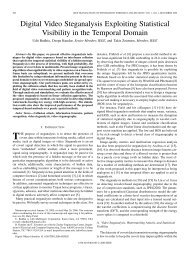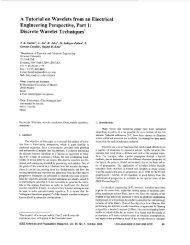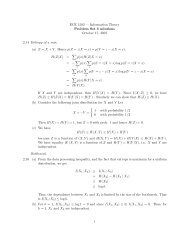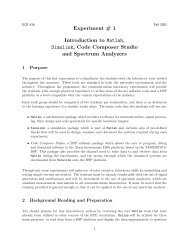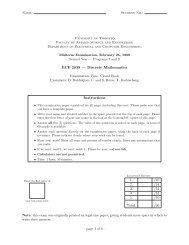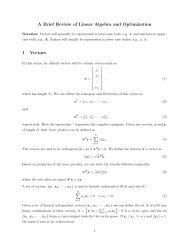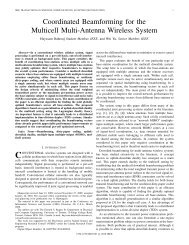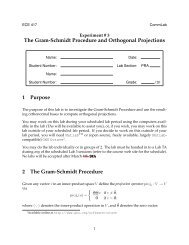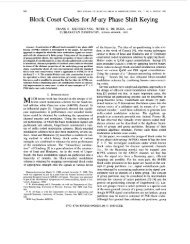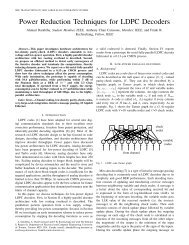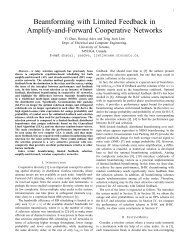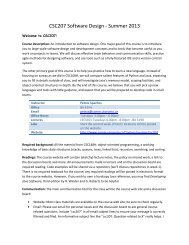Beam-forming by mutual coupling effects of parasitic elements in ...
Beam-forming by mutual coupling effects of parasitic elements in ...
Beam-forming by mutual coupling effects of parasitic elements in ...
Create successful ePaper yourself
Turn your PDF publications into a flip-book with our unique Google optimized e-Paper software.
<strong>Beam</strong>-<strong>form<strong>in</strong>g</strong> <strong>by</strong> <strong>mutual</strong> <strong>coupl<strong>in</strong>g</strong> <strong>effects</strong> <strong>of</strong> <strong>parasitic</strong> <strong>elements</strong> <strong>in</strong> antenna arrays<br />
*Rubaiyat Islam, University <strong>of</strong> Toronto, Toronto, ON, Canada<br />
Raviraj Adve, University <strong>of</strong> Toronto, Toronto, ON, Canada<br />
An <strong>in</strong>novative way <strong>of</strong> beam-<strong>form<strong>in</strong>g</strong> is described us<strong>in</strong>g <strong>mutual</strong> <strong>coupl<strong>in</strong>g</strong> <strong>effects</strong> <strong>of</strong><br />
<strong>parasitic</strong> <strong>elements</strong> <strong>in</strong> an antenna array. It is shown that null and ma<strong>in</strong>beam<br />
placement can be achieved <strong>by</strong> vary<strong>in</strong>g the reactances at the center <strong>of</strong> the dipoles.<br />
1. Introduction<br />
Traditional beam-<strong>form<strong>in</strong>g</strong> is achieved <strong>by</strong> vary<strong>in</strong>g the complex ga<strong>in</strong> <strong>of</strong> an antenna-array<br />
[1]. The electromagnetic waves radiated from different segments <strong>of</strong> the array comb<strong>in</strong>e <strong>in</strong>phase<br />
(and out <strong>of</strong> phase) to form the major lobes (and nulls) at desired directions.<br />
Controll<strong>in</strong>g the complex ga<strong>in</strong> is expensive, as it requires sophisticated RF circuitry for<br />
each element. As a result such antennas are available only for specialized applications<br />
such as <strong>in</strong> the military. A cost-effective solution for mobile communication is to exploit<br />
the electromagnetic <strong>mutual</strong> <strong>coupl<strong>in</strong>g</strong> between <strong>elements</strong> to achieve beam-<strong>form<strong>in</strong>g</strong> [2].<br />
This paper outl<strong>in</strong>es the design <strong>of</strong> a five-element wire dipole antenna array. The center<br />
element is fed <strong>by</strong> a source and the rema<strong>in</strong><strong>in</strong>g four <strong>elements</strong> are placed equidistant to each<br />
other on a circle centered around it. Variable impedances on the four <strong>parasitic</strong> <strong>elements</strong><br />
are controlled to place nulls and ma<strong>in</strong> beams at desired locations <strong>in</strong> the far-field radiation<br />
pattern.<br />
2. Theory<br />
The radiation pattern <strong>of</strong> a s<strong>in</strong>gle center-fed vertical wire dipole is constant (<strong>in</strong> all<br />
directions) <strong>in</strong> the horizontal plane. If another vertical wire dipole (passive) is brought to<br />
its vic<strong>in</strong>ity, alter<strong>in</strong>g its center impedances will change the current pattern <strong>in</strong> each element.<br />
It is anticipated that <strong>by</strong> tun<strong>in</strong>g these impedances it will be possible <strong>in</strong>troduce nulls and<br />
ma<strong>in</strong> beams at desired locations.<br />
Rigorous formulation <strong>of</strong> the problem is possible <strong>by</strong> us<strong>in</strong>g Maxwell’s equations to obta<strong>in</strong><br />
the tangential electric field on the surface <strong>of</strong> the dipoles:<br />
where primed quantities denote source po<strong>in</strong>ts, unprimed ones are field po<strong>in</strong>ts and R is the<br />
distance between them. This equation may be solved us<strong>in</strong>g the method <strong>of</strong> moments [3].<br />
Rectangular basis and trial functions <strong>of</strong> unit height and width ∆ are used. The Method <strong>of</strong><br />
Moments reduces the <strong>in</strong>tegral equation to the matrix equation:<br />
V’ M.N x1 = Z MN x MN I MN x1 (2)<br />
where M is the number <strong>of</strong> <strong>elements</strong> <strong>in</strong> the array and N is the number <strong>of</strong> subsections per<br />
element. The vector I is the current and V’ is the voltage across each subsection. As the<br />
tangential electric field on the surface <strong>of</strong> a conductor is zero; V’ is all zeros except for the<br />
entries correspond<strong>in</strong>g to the air-gap regions at the center <strong>of</strong> each dipole. These non zero
terms are <strong>of</strong> the form V i -z i I i with the subscript referr<strong>in</strong>g to the center <strong>of</strong> the i’th dipole <strong>in</strong><br />
the array and z i be<strong>in</strong>g the variable impedance at that po<strong>in</strong>t. For the array described <strong>in</strong> this<br />
paper, only one element is excited <strong>by</strong> a source. Hence, only V 1 , correspond<strong>in</strong>g to the<br />
active element, is non-zero. All <strong>of</strong> the above, allows equation (2) to be expressed as:<br />
V = (Z+Z L )I or I = (Z+Z L ) -1 V (3)<br />
where Z L is a diagonal matrix isolat<strong>in</strong>g the z i I i terms from V’ leav<strong>in</strong>g V with only one<br />
non-zero term correspond<strong>in</strong>g to V 1 – i.e. the s<strong>in</strong>gle excitation voltage <strong>in</strong> the array.<br />
z<br />
M=5<br />
λ<br />
y<br />
λ/2<br />
λ/2<br />
x<br />
V 1<br />
Z 1<br />
Figure 1- Antenna configuration<br />
Figure 2 –current magnitude vs. separation<br />
Note that for the antenna configuration shown <strong>in</strong> figure 1, the far-field radiation pattern is<br />
given <strong>by</strong>:<br />
where ∆ is the width <strong>of</strong> each subsection, R represents the distance from the far-field po<strong>in</strong>t<br />
to the center <strong>of</strong> the active element. For this array, φ is the azimuthal angle (<strong>in</strong> the<br />
spherical coord<strong>in</strong>ate system) and φ m is the horizontal angle between the x-axis and the<br />
center <strong>of</strong> the m’th element. In equation (4) R m represents the horizontal distance <strong>of</strong> each<br />
element from the orig<strong>in</strong> and I mn is the current <strong>in</strong> the n’th segment <strong>of</strong> the m’th element <strong>in</strong><br />
the array<br />
From (4), the radiation <strong>in</strong>tensity <strong>in</strong> any given direction is a function <strong>of</strong> the current I <strong>in</strong> the<br />
antenna and from (3) I itself is a function <strong>of</strong> center impedances Z L . The simulations<br />
outl<strong>in</strong>ed <strong>in</strong> this paper <strong>in</strong>volve vary<strong>in</strong>g only the reactance part <strong>of</strong> z i to maximize/m<strong>in</strong>imize<br />
(4) <strong>in</strong> a given direction.<br />
This <strong>in</strong>volves a non-l<strong>in</strong>ear m<strong>in</strong>imization problem <strong>of</strong> (M-1) (4 <strong>in</strong> the case described)<br />
<strong>in</strong>dependent variables. The trust-region method [4,5] <strong>of</strong> non-l<strong>in</strong>ear m<strong>in</strong>imization is used<br />
to obta<strong>in</strong> solutions to the problem. At each iteration, the radiation pattern <strong>in</strong> (4) can be<br />
represented <strong>by</strong> a quadratic approximation:
E θ (S) = E 0 + a T S + ½ S T HS (5)<br />
where H is the Hessian Matrix – a symmetric matrix <strong>of</strong> second derivatives<br />
(H ij =∂ 2 E θ /∂x i ∂x j ) def<strong>in</strong><strong>in</strong>g the curvature <strong>of</strong> E θ <strong>in</strong> the ellipsoidal neighborhood<br />
||CS||< δ where C is a diagonal matrix. In equation (5), S=X-X 0 where X is the vector <strong>of</strong><br />
center reactances <strong>of</strong> the <strong>elements</strong> <strong>in</strong> the array and X 0 is the center <strong>of</strong> the neighborhood<br />
be<strong>in</strong>g approximated. The gradient <strong>of</strong> the surface <strong>in</strong> (5) for all S <strong>in</strong> the ellipsoidal<br />
neighborhood can be computed <strong>by</strong><br />
g = a + HS (6)<br />
The problem <strong>of</strong> optimiz<strong>in</strong>g (4) <strong>in</strong> the region l
Figure 4. shows maxima obta<strong>in</strong>ed at desired locations <strong>in</strong> far-field. The algorithm used is<br />
identical to that <strong>of</strong> the m<strong>in</strong>imization problem, except that the negative <strong>of</strong> (5) was<br />
m<strong>in</strong>imized – which is the equivalent <strong>of</strong> maximiz<strong>in</strong>g the electric field vector. Fig 4 (a)<br />
converged after 22 iterations and Fig 4(b) converged after 24 iterations.<br />
Figure 3 – Nulls at desired locations<br />
Figure 4 – Ma<strong>in</strong> beam at desired locations<br />
4. Conclusion<br />
As demonstrated, a new type <strong>of</strong> smart antenna can be implemented with beam steer<strong>in</strong>g<br />
and beam <strong>form<strong>in</strong>g</strong> capabilities us<strong>in</strong>g only one active element. By vary<strong>in</strong>g the load<br />
impedances <strong>of</strong> the <strong>parasitic</strong> <strong>elements</strong>, nulls and ma<strong>in</strong> beams can be placed at desired<br />
directions. The advantage <strong>of</strong> us<strong>in</strong>g such an array is that it is more cost effective compared<br />
to conventional ones requir<strong>in</strong>g sophisticated RF circuitry to handle their complex ga<strong>in</strong><br />
requirements. The array described <strong>in</strong> this paper takes advantage <strong>of</strong> <strong>mutual</strong> <strong>coupl<strong>in</strong>g</strong><br />
<strong>effects</strong> between <strong>elements</strong>. Further <strong>in</strong>vestigation <strong>of</strong> the variation <strong>of</strong> the beam-pattern with<br />
load reactances is needed before beams and nulls can be formed more efficiently and<br />
before global optimization can be achieved (over the reactance bounds).<br />
5. References<br />
[1] C. A. Balanis, Antenna theory: analysis and design, Second Edition, Wiley, New<br />
York, 1997<br />
[2] R. F. Harr<strong>in</strong>gton, “Reactively controlled directive arrays,” IEEE Trans. Antennas and<br />
Propagation, AP-26, Vol. 3, pp. 390-395, 1978.<br />
[3] R. F. Harr<strong>in</strong>gton, Field computation <strong>by</strong> moment methods, Macmillan, NY, 1968<br />
[4] Coleman, T.F. and Y. Li, "An Interior, Trust Region Approach for Nonl<strong>in</strong>ear<br />
M<strong>in</strong>imization Subject to Bounds," SIAM Journal on Optimization, Vol. 6, pp. 418-445,<br />
1996.<br />
[5] Fletcher, R. and M.J.D. Powell, "A Rapidly Convergent Descent Method for<br />
M<strong>in</strong>imization," Computer Journal, Vol. 6, pp. 163-168, 1963.



